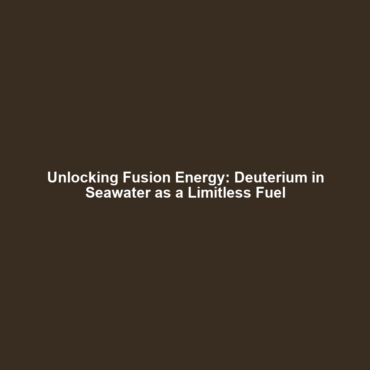Early Research: Fusion as an Energy Source
Since the mid-20th century, the pursuit of fusion energy has been a critical area of scientific inquiry. Early research laid the groundwork for understanding how fusion could provide a sustainable and virtually limitless energy source. The significance of these initial investigations into fusion energy cannot be overstated, as they contribute to the broader discourse surrounding clean, renewable energy solutions, essential for combating climate change and reducing dependence on fossil fuels.
Key Concepts of Early Fusion Research
The study of fusion energy involves several major concepts that emerged from early theoretical work and experimental efforts. Understanding these principles helps contextualize fusion within the broader energy landscape:
- Nuclear Fusion: The process where two light atomic nuclei combine to form a heavier nucleus, releasing significant amounts of energy.
- Conditions for Fusion: High temperature and pressure are essential for overcoming the electrostatic repulsion between positively charged nuclei.
- Plasma Physics: The study of charged particles and fluids interacting, which is vital for creating and sustaining fusion reactions.
- Magnetic Confinement: Techniques, such as tokamaks, used to contain plasma and maintain the conditions necessary for fusion.
Applications and Real-World Uses of Early Fusion Research
The applications of early fusion research have been evolving, leading to significant implications in various fields, including:
- Energy Production: Transitioning to fusion power could change how we source energy on a global scale.
- Medical Isotopes: Fusion technology can potentially aid in the production of isotopes used in medical imaging and cancer treatment.
- Space Exploration: Future propulsion systems might utilize fusion to enable long-distance space travel.
These applications of early research in fusion energy demonstrate its transformative potential in reshaping energy production and harnessing new technologies for societal benefit.
Current Challenges in Fusion Research
Despite the promising advancements, several challenges persist in the study and application of fusion energy:
- High energy input required for sustaining fusion reactions.
- Complexities in plasma confinement and stability.
- Costly experimental setups and long development timelines.
- Regulatory and safety concerns related to fusion reactors.
These challenges of early fusion research highlight the necessity for continued investment and innovation in the field.
Future Research and Innovations in Fusion Energy
Looking ahead, numerous ongoing and upcoming research efforts aim to address the limitations currently faced in fusion energy. Some potential breakthroughs may include:
- Development of advanced materials that can withstand extreme conditions.
- Innovative magnetic confinement techniques, including stellarators and inertial confinement methods.
- Research on alternative fusion fuels, such as deuterium and tritium.
- Funding and international collaboration initiatives focusing on fusion projects.
These innovations could be pivotal in transforming the theoretical potential of fusion energy into a practical reality.
Conclusion
Early research into fusion as an energy source since the mid-20th century has fundamentally shaped our understanding of this powerful potential energy source. By exploring key concepts, practical applications, and current challenges, the relevance of fusion energy in the modern world becomes evident. As research progresses, the possibility of harnessing fusion energy for widespread use is becoming increasingly plausible. For further reading on the latest advancements in fusion technology, consider exploring related topics on our website.





